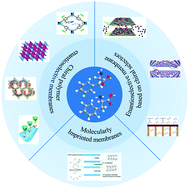Advances of enantioselective solid membranes
Abstract
Enantiomers differ greatly in their pharmacological and toxicological activities, and chirality is closely correlated with many significant biological processes; the separation of racemates is of great importance. Compared with traditional chiral separation methods such as crystallization, chromatographic separation and kinetic enzyme resolution, use of solid-state enantioselective membranes has the advantages of low energy consumption, simple equipment, and sustainable operation. Therefore, they are more suitable for the needs of large-scale industrial production. Herein, we discuss the theoretical and experimental developments in the emerging field of solid-state chiral separation membranes, focusing on the fundamental mechanisms of chiral molecule transport. Moreover, we highlight the advantages and disadvantages of different types of chiral separation membranes and their potential functional characteristics. Finally, the future trends of solid-state enantioselective membranes are proposed in this review, and we hope to provide some helpful ideas for researchers in the area.

- This article is part of the themed collection: 2021 Focus and Perspective articles


 Please wait while we load your content...
Please wait while we load your content...